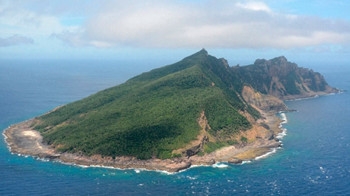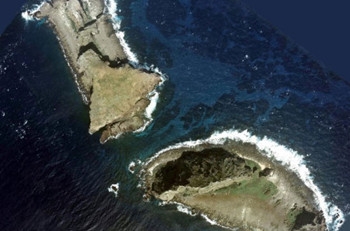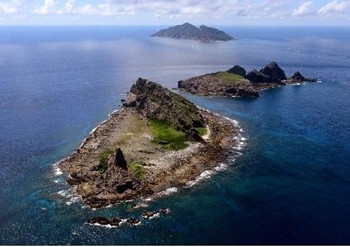1885年9月22日沖繩縣令在對釣魚島進行秘密調查后向內務卿山縣有朋密報稱,這些無人島“與《中山傳信錄》記載的釣魚臺、黃尾嶼和赤尾嶼應屬同一島嶼”,已為清朝冊封使船所詳悉,并賦以名稱,作為赴琉球的航海標識,因此對是否應建立國家標樁心存疑慮,請求給予指示。同年10月9日,內務卿山縣有朋致函外務卿井上馨征求意見。10月21日,井上馨復函山縣有朋認為,“此刻若有公然建立國標等舉措,必遭清國疑忌,故當前宜僅限于實地調查及詳細報告其港灣形狀、有無可待日后開發之土地物產等,而建國標及著手開發等,可待他日見機而作”。井上馨還特意強調,“此次調查之事恐均不刊載官報及報紙為宜”。因此,日本政府沒有同意沖繩縣建立國家標樁的請求。
After the secret facts-finding missions to Diaoyu Dao, the governor of Okinawa Prefecture sent a report in secrecy to the Minister of Internal Affairs Yamagata Aritomo on September 22, 1885, saying that these uninhabited islands were, in fact, the same Diaoyu Tai, Huangwei Yu and Chiwe Yu that were recorded in the Records of Messages from Chong-shan (Zhong Shan Chuan Xin Lu) and known well to imperial title-conferring envoys of the Qing court on their voyages to Ryukyu, and that he had doubts as to whether or not sovereignty markers should be set up and therefore asked for instruction. The Minister of Internal Affairs Yamagata Aritomo solicited opinion from the Foreign Minister Inoue Kaoru on October 9. Inoue Kaoru replied in a letter to Yamagata Aritomo on October 21, "At present, any open moves such as placing sovereignty markers are bound to alert the Qing imperial court. Therefore, it is advisable not to go beyond field surveys and detailed reports on the shapes of the bays, land and other resources for future development. In the meantime, we will wait for a better time to engage in such activities as putting up sovereignty markers and embarking on development on the islands." Inoue Kaoru also made a special emphasis that "it is inappropriate to publicize the missions on official gazette or newspapers." As a result, the Japanese government did not approve of the request of Okinawa Prefecture to set up sovereignty markers.
1890年1月13日,沖繩縣知事又請示內務大臣,稱釣魚島等島嶼“為無人島,迄今尚未確定其管轄”,“請求將其劃歸本縣管轄之八重山官署所轄”。1893年11月2日,沖繩縣知事再次申請建立國標以劃入版圖。日本政府仍未答復。甲午戰爭前兩個月,即1894年5月12日,沖繩縣秘密調查釣魚島的最終結論是:“自明治十八年(1885年)派縣警察對該島進行勘察以來,未再開展進一步調查,故難提供更確切報告。……此外,沒有關于該島之舊時記錄文書以及顯示屬我國領有的文字或口頭傳說的證據。”
The governor of Okinawa Prefecture submitted the matter for approval to the Minister of Internal Affairs once again on January 13, 1890, saying that Diaoyu Dao and other "above-mentioned uninhabited islands have remained under no specific jurisdiction", and that he "intends to place them under the jurisdiction of the Office of Yaeyama Islands." On November 2, 1893, the governor of Okinawa Prefecture applied once again for setting up sovereignty markers to incorporate the islands into Japan's territory. The Japanese government did not respond. On May 12, 1894, two months before the Sino-Japanese War, the secret facts-finding missions to Diaoyu Dao by Okinawa Prefecture came to a final conclusion, "Ever since the prefecture police surveyed the island in 1885 (the 18th year of the Meiji period), there have been no subsequent investigations. As a result, it is difficult to provide any specific reports on it... In addition, there exist no old records related to the said island or folklore and legends demonstrating that the island belongs to our country."
日本外務省編纂的《日本外交文書》明確記載了日本企圖竊取釣魚島的經過,相關文件清楚地顯示,當時日本政府雖然覬覦釣魚島,但完全清楚這些島嶼屬于中國,不敢輕舉妄動。
Japan's attempts to occupy Diaoyu Dao were clearly recorded in Japan Diplomatic Documents compiled by the Japanese Foreign Ministry. Relevant documents evidently show that the Japanese government intended to occupy Diaoyu Dao, but refrained from acting impetuously as it was fully aware of China's sovereignty over these islands.
















